Editorial
What a month! Impossible software development deadlines while under-staffed; "precious" egotistical engineers behaving like children; their boss not behaving much better... just as well I love it! So zero shop activity, but I think we've got enough other stuff to make up for it. Also, last month we had 8,500 odd hits: a new record! This issue is something of a milestone-month as June marks the second anniversary of the rash decision to publish a monthly web-zene dedicated to model engines, model engine making, and related stuff. That makes this Issue #25 and so far, I've not missed a dead-line (alright, December 2003 was a little late, but that was not my fault!). Can Ron manage to keep it all together for another year? Well, we'll see.
Also this month, Model Engine News has a World Exclusive (woohoo!) for you. While most of this month has been 7 day working weeks for me, a phone call from Peter Burford made me an offer I couldn't refuse: take a whole Saturday off and visit him in his idyllic shop, high in the Gold Coast hinterland. What made this offer un refusable was the opportunity to examine his new engine and the tools, fixtures, jigs, dies, and machinery that he uses to make it. The day was about as delightful as they come (and a good excuse to give the GPS navigator in the Boxter a workout). I took a lot of worse-than-usual photos and have spent most of this month's writing budget trying to remember what was said and wrap some half-way sensible words about the pics. The engine is introduced as the Engine of the Month, but I think you'll find the treatment a little different from the usual format.
Part of the development work my team at DSTC has been involved with in this past month has required that we go more deeply into HTML "style sheets" than previously, and look closely at the incompatibilities between Mozilla, Netscape Navigator, and Microsoft's Internet Explorer. A side-effect of this is a re-vamp of this web site that hopefully will make viewing and printing of pages, easier, faster, and more tolerant of your preferred brand in browsers. I'll slowly back-fit this upgrade to all past editorial pages—in fact this will be a mandatory step before the MEN Only CD can be produced. Speaking of which, equipment has been purchased for printing labels direct on the CD, so we are a little closer; be patient. By the way, while making mention in passing of Microsoft, there are only 20 months remaining until it delivers the cure for Spam.
An Unusual Feeney Connection
There are good days and bad. Bad days are when angry, impolite emails arrive—usually telling me I've got something totally wrong, or blasting me for reporting something said by others. Even though they are usually 100% right about my wrongness, it hurts. As long-time readers will I hope be aware, I'm never backwards about 'fessing up to ignorance and incorrect assumptions—which is just as well given how often I seem to dine out on crow—but there's no need to be rude.
Good days are when I get an email saying that my web site has been useful to someone, sometimes in unexpected ways. It is not now, and never will be my policy to "name names". I've often felt that the "Letters To The Editor" columns in commercial magazines are a thinly disguised device used to make up the page count on slow months. Or worse, opportunities for unscrupulous editors to float Dorothy-Dix'ers and have the Last Sanctimonious Word. Now having said all that, you might guess that I'm about to bend (ar at most flex) my own rule, and you'd be right. But there's a point to it.
This month I received a nice email from the granddaughter of Casimir Leja. Barb (married name supplied but withheld) had been researching her grandfather on the web to assist her daughter (Lieja's great-granddaughter) with a school project on immigration and getting nowhere until she recalled that he had worked on motorcycle engines, so a search for "engines" + "Leja" found my Feeney page (an engine designed by Cass Leja). I'm sorry that writing up that piece exhausted my references to Barb's grandfather's accomplishments, so I was unable to provide any additional information about his life and accomplishments. All the same, what I did have was more than she had been able to uncover, so it sort of made my day and gave me the encouragement to keep all this up a while longer.
You Didn't Hear This From Me...
The Internet is a fantastic resource. A quick search will provide you with instructions on how to make all sorts of things, from model engines to dirty atom bombs. The information itself is benign—it's how it's applied that can lead to anti-social behavior, like noise complaints. What I'm about to disclose might be termed anti-social behavior by some, but take it in the spirit it's offered.
In the bad old days when we kids mixed our own diesel fuel, we'd cycle down to the local chemist store (drug store to US readers) and buy small bottles of medicinal ether and castor oil. Rich kids would also buy an even tinier ampoule of amyl nitrate and dribble a few drops in for extra urge. If you've tried to buy ether lately, you'll likely have found that its use in back-yard labs for producing certain "party drugs" has made obtaining it very, very difficult. As for amyl nitrate—a serious heart stimulant—forget it!
Well just this month, a source who should (and will  ) remain anonymous, let me into a secret: amyl nitrate is to be had in small but affordable quantities from the same party animals that have contributed to the unavailability of ether (now there's poetic justice for you!). It goes under the name of "Rush", and modesty restrains me from describing the prime reason why people who go to the sort of parties I never seem to get asked to (anymore) indulge in sniffing the stuff. The usual proportion for diesel fuel is 2% by volume for pure amyl nitrate. "Rush" is probably cut, so going a little higher would probably be the go. So speak to your un-closeted friends and just remember, you didn't hear about it from me, ok?
) remain anonymous, let me into a secret: amyl nitrate is to be had in small but affordable quantities from the same party animals that have contributed to the unavailability of ether (now there's poetic justice for you!). It goes under the name of "Rush", and modesty restrains me from describing the prime reason why people who go to the sort of parties I never seem to get asked to (anymore) indulge in sniffing the stuff. The usual proportion for diesel fuel is 2% by volume for pure amyl nitrate. "Rush" is probably cut, so going a little higher would probably be the go. So speak to your un-closeted friends and just remember, you didn't hear about it from me, ok?
Engine Of The Month: PB 020 Diesel
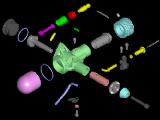 I think my love of "diesel" (compression ignition) engines is well known to regular readers, as is my love for the Australian produced Taipans. Maybe it was because a "bubble pack" Taipan 1.5 was my first engine, or maybe it was the rush I got from blowing the amyl nitrate laden fuel out of flooded engines, but whatever the reason, the attraction (addiction?) has been a lasting one. Taipans were designed and manufactured by Gordon Burford and the story has been told idiosyncratically by Ivor F in Model Engine World, although I don't believe he mentioned that from the 60's on, Gordon was assisted by his oldest son, Peter. Peter apprenticed with his father, and stayed with the family business through to the end when it became obvious that despite building a world class product, it was uneconomically to continue competing in a comparatively small niche market from an Australian manufacturing base. So Gordon retired and Peter changed direction into injection molding and die making.
I think my love of "diesel" (compression ignition) engines is well known to regular readers, as is my love for the Australian produced Taipans. Maybe it was because a "bubble pack" Taipan 1.5 was my first engine, or maybe it was the rush I got from blowing the amyl nitrate laden fuel out of flooded engines, but whatever the reason, the attraction (addiction?) has been a lasting one. Taipans were designed and manufactured by Gordon Burford and the story has been told idiosyncratically by Ivor F in Model Engine World, although I don't believe he mentioned that from the 60's on, Gordon was assisted by his oldest son, Peter. Peter apprenticed with his father, and stayed with the family business through to the end when it became obvious that despite building a world class product, it was uneconomically to continue competing in a comparatively small niche market from an Australian manufacturing base. So Gordon retired and Peter changed direction into injection molding and die making.
Even though he asserts he's not a "modeller", Peter has a passion for small engines, so much so that he has managed to realize a dream of building a premium quality engine, designed and developed by himself, and manufactured by himself alone in his very, very well appointed home workshop on the ground floor of his new home nestled away in the foothills of the Tallebudgera hinterland. Peter phoned me last month, offering an opportunity to visit, chat, and be the first to publish an independent review of his engine. The material I gathered is a bit larger than I like to layout in the Editorial page, so click the link to the Peter Burford 020 page and visit his website at http://www.peterburford.com.au (which I consider to be one of the most simple yet attractive web sites I've ever seen—the layout is spacious and uncluttered; nothing flashes, rotates, or makes noises, and the color selection is harmonious and pleasing—I wish my cluttered mess was one quarter as good).
While we were chatting, Peter asked what I thought of an idea he had to make his engine building available on the net via a web-cam. This would be "by subscription only" deal which would show how Peter goes about the more obscure processes that go into commercial manufacture of small engines, like grinding of crankshafts, honing of liners, use of his turret lathes etc, etc. Just vision, no sound. It sounded like a fascinating idea to me, so if this sounds like something you'd be prepared to subscribe to, let me, or better still, let Peter know. There's nothing definite at this time—this is very much a flag flying exercise—but one certainly worthy of thinking further about.
ETW
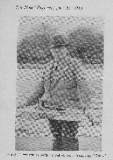 Seems like not a month goes by lately without me finding need to mention or reference the work of English model engine designer, Edgar T Westbury. Writing in the Model Engineer under his own name and two pen-names, "ETW" produced articles, designs, and musings on all manner of power-plants, both internal and external combustion, together with material on model engineering techniques and practices. With all that, I've decided it's about time the website sprouted an Edgar T Westbury Tribute Page to sit beside the Lawrence H Sparey page—although Westbury's prolific output will probably result in his page becoming more of a tree. So use the link to see the first part of my research into his life and his work. As the page is added to, I'll mention the additions here. Now, where to place the main link? Hmmmm... difficult...
Seems like not a month goes by lately without me finding need to mention or reference the work of English model engine designer, Edgar T Westbury. Writing in the Model Engineer under his own name and two pen-names, "ETW" produced articles, designs, and musings on all manner of power-plants, both internal and external combustion, together with material on model engineering techniques and practices. With all that, I've decided it's about time the website sprouted an Edgar T Westbury Tribute Page to sit beside the Lawrence H Sparey page—although Westbury's prolific output will probably result in his page becoming more of a tree. So use the link to see the first part of my research into his life and his work. As the page is added to, I'll mention the additions here. Now, where to place the main link? Hmmmm... difficult...
Kestrel Revisited
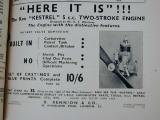 More corrections and retractions in relation to the Westbury Kestrel are now in order. Plans for it and the Kinglet were available from the ME, as I would have seen if I'd looked in more than one ME plans catalogue before running off at the keyboard last month (PE3 and PE4 respectively). It also appears that over the years, castings for the Kestrel have been available from a number of places, including die castings. The pic here was taken from a 1938 issue of the Model Engineer which actually predates the publication of the construction series. The company in question also provided castings for a 15cc Westbury four-stroke that they called the "Ken", and which I believe was the Kiwi (want to bet I've got that wrong too?).
More corrections and retractions in relation to the Westbury Kestrel are now in order. Plans for it and the Kinglet were available from the ME, as I would have seen if I'd looked in more than one ME plans catalogue before running off at the keyboard last month (PE3 and PE4 respectively). It also appears that over the years, castings for the Kestrel have been available from a number of places, including die castings. The pic here was taken from a 1938 issue of the Model Engineer which actually predates the publication of the construction series. The company in question also provided castings for a 15cc Westbury four-stroke that they called the "Ken", and which I believe was the Kiwi (want to bet I've got that wrong too?).
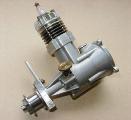 A UK reader sent me some photos of his Kestrel, produced from castings made from his own patterns that are superb. I'm sorry that time has not allowed me to lay all of these out in the manner they deserve and I promise to do so Real Soon Now. But in the meantime, this photo shows the forward facing venturi arrangement, and the screw that closes off the hole drilled under the crankcase that connects the fuel tank to the spray bar. Also visible below the venturi is a tiny hole that allowed excess fuel resulting from the "head" in a full tank to drain away if the engine was left fueled and standing. I'm warming to this engine almost as much as the Kinglet.
A UK reader sent me some photos of his Kestrel, produced from castings made from his own patterns that are superb. I'm sorry that time has not allowed me to lay all of these out in the manner they deserve and I promise to do so Real Soon Now. But in the meantime, this photo shows the forward facing venturi arrangement, and the screw that closes off the hole drilled under the crankcase that connects the fuel tank to the spray bar. Also visible below the venturi is a tiny hole that allowed excess fuel resulting from the "head" in a full tank to drain away if the engine was left fueled and standing. I'm warming to this engine almost as much as the Kinglet.
New Books and Magazines This Month
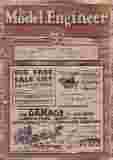 (This piece best read with the Beatles playing When I'm 64 quietly in the background...). Our subject publication this month starts with The Model Engineer for the week of Thursday January 6, 1938, and is obviously not "new", nor to my deep regret, does it permanently reside in the MEN Only library. I've again imposed on the good graces of Russ Watson-Will to loan me volumes 77 and 78 of the ME to assist in research into the Westbury Kestrel and Kinglet designs. The big surprise is what a wonderful treasure house a 64 year old magazine can be! First, look at the price: "4d" (that's four-pence in the UK), uplifted by a pencil stroke and 50% for sale in Australia at sixpence! Sounds trivial, but I wonder what fraction of the average wage that represented in 1938? A quick Google search failed to find the Australian figure, but the figure for the US minimum Federal hourly rate in 1938 was 25 cents, so 6d, which is equivalent to 5 cents, assuming one Australian pound equaled two American dollars, and a 40 hour week, makes it one-half a percent of your before-tax pay packet. But we digress...
(This piece best read with the Beatles playing When I'm 64 quietly in the background...). Our subject publication this month starts with The Model Engineer for the week of Thursday January 6, 1938, and is obviously not "new", nor to my deep regret, does it permanently reside in the MEN Only library. I've again imposed on the good graces of Russ Watson-Will to loan me volumes 77 and 78 of the ME to assist in research into the Westbury Kestrel and Kinglet designs. The big surprise is what a wonderful treasure house a 64 year old magazine can be! First, look at the price: "4d" (that's four-pence in the UK), uplifted by a pencil stroke and 50% for sale in Australia at sixpence! Sounds trivial, but I wonder what fraction of the average wage that represented in 1938? A quick Google search failed to find the Australian figure, but the figure for the US minimum Federal hourly rate in 1938 was 25 cents, so 6d, which is equivalent to 5 cents, assuming one Australian pound equaled two American dollars, and a 40 hour week, makes it one-half a percent of your before-tax pay packet. But we digress...
The issue pictured began two noteworthy series. The first was by none other than this month's fixation, Edgar T Westbury: A Working Model Road Roller. This is worth mentioning because it was powered by a water-hopper cooled, four-stroke engine that would make a wonderful project, even without the infinitely variable forward-reverse transmission, differential drive and other heavy iron bits. The second item was the first in a series titled Tool Room Topics which, over the next year, described how tool-room craftsmen of the day made punching and blanking dies, delving into the mysteries of stripper-plates, finger-stops, and all manner of things that most people today would not have a clue about.
Now while I believe that the Model Engineer magazine today is still a relatively good publication, it lacks the diversity of these old issues and because of the exchange rate between England and Australia, it is just too expensive for the occasional article of interest for me to justify threatening my house foundations with. Instead, I prefer to pick up the occasional volume from yesteryear, though generally the freight cost exceeds that of the bound volume of 24 issues! Excellent reading and highly recommended.
Tech Tip of the Month: Piston Rings
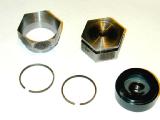 The plan was to delve into the Trimble method of piston ring manufacture this month, but as mentioned, things have kinda got away from me, so this will have to wait for next month. But just to whet your appetites, here is a shot showing a pair of finished Feeney rings and the fixtures used to produce them (together with the piston installing tool). If it all looks a bit mysterious, wait for next month, and if it looks all quite ho-hum and straight-forward, you probably won't care if that installment is late
The plan was to delve into the Trimble method of piston ring manufacture this month, but as mentioned, things have kinda got away from me, so this will have to wait for next month. But just to whet your appetites, here is a shot showing a pair of finished Feeney rings and the fixtures used to produce them (together with the piston installing tool). If it all looks a bit mysterious, wait for next month, and if it looks all quite ho-hum and straight-forward, you probably won't care if that installment is late  .
.
Model Engine Books; Present, Past, and Future
An email from Ken Croft (presently watching tether cars scream around a track in the Black Forest and practicing his German), informs us that John Goodall, one-time editor of Model Engine World, has completed a book on the Oliver Tiger, aptly titled The Olivers and a Tiger, hard-bound, 230 pictures, price UKP20. Ken says it is excellent. A review will follow here in due course.
Speaking of Model Engine World (the new one), I paid my annual four issue sub (through Wise Owl) quite some time back and have seen *nothing*. A check on the web site gives a very distressing HTTP 220 Not Found. Further investigation obviously required. I'll report back next month.
And Finally, an email from noted Australian C/L speed flyer, Maris Dislers, informs me that he is nearing the end of his magnum opus which will present the definitive story of Gordon Burford's engines and all their myriad needle valve variants—a most daunting task! Maris was asking permission to use some of my photos and words regarding the use of darning needles—a request I was only too delighted to consent with. There's no projected availability date yet, but I'll let you know here as soon as I have something more definite.
 An Unusual Feeney Connection
An Unusual Feeney Connection
 You Didn't Hear This From Me...
You Didn't Hear This From Me...
 ETW
ETW
 Kestrel Revisited
Kestrel Revisited
 Model Engine Books; Present, Past, and Future
Model Engine Books; Present, Past, and Future
 Editorial
Editorial
 New Books and Magazines This Month
New Books and Magazines This Month
 Engine Of The Month: PB 020 Diesel
Engine Of The Month: PB 020 Diesel
 Tech Tip of the Month: Piston Rings
Tech Tip of the Month: Piston Rings
 Standard Stuff
Standard Stuff
![]()
 ) remain anonymous, let me into a secret: amyl nitrate is to be had in small but affordable quantities from the same party animals that have contributed to the unavailability of ether (now there's poetic justice for you!). It goes under the name of "Rush", and modesty restrains me from describing the prime reason why people who go to the sort of parties I never seem to get asked to (anymore) indulge in sniffing the stuff. The usual proportion for diesel fuel is 2% by volume for pure amyl nitrate. "Rush" is probably cut, so going a little higher would probably be the go. So speak to your un-closeted friends and just remember, you didn't hear about it from me, ok?
) remain anonymous, let me into a secret: amyl nitrate is to be had in small but affordable quantities from the same party animals that have contributed to the unavailability of ether (now there's poetic justice for you!). It goes under the name of "Rush", and modesty restrains me from describing the prime reason why people who go to the sort of parties I never seem to get asked to (anymore) indulge in sniffing the stuff. The usual proportion for diesel fuel is 2% by volume for pure amyl nitrate. "Rush" is probably cut, so going a little higher would probably be the go. So speak to your un-closeted friends and just remember, you didn't hear about it from me, ok?





